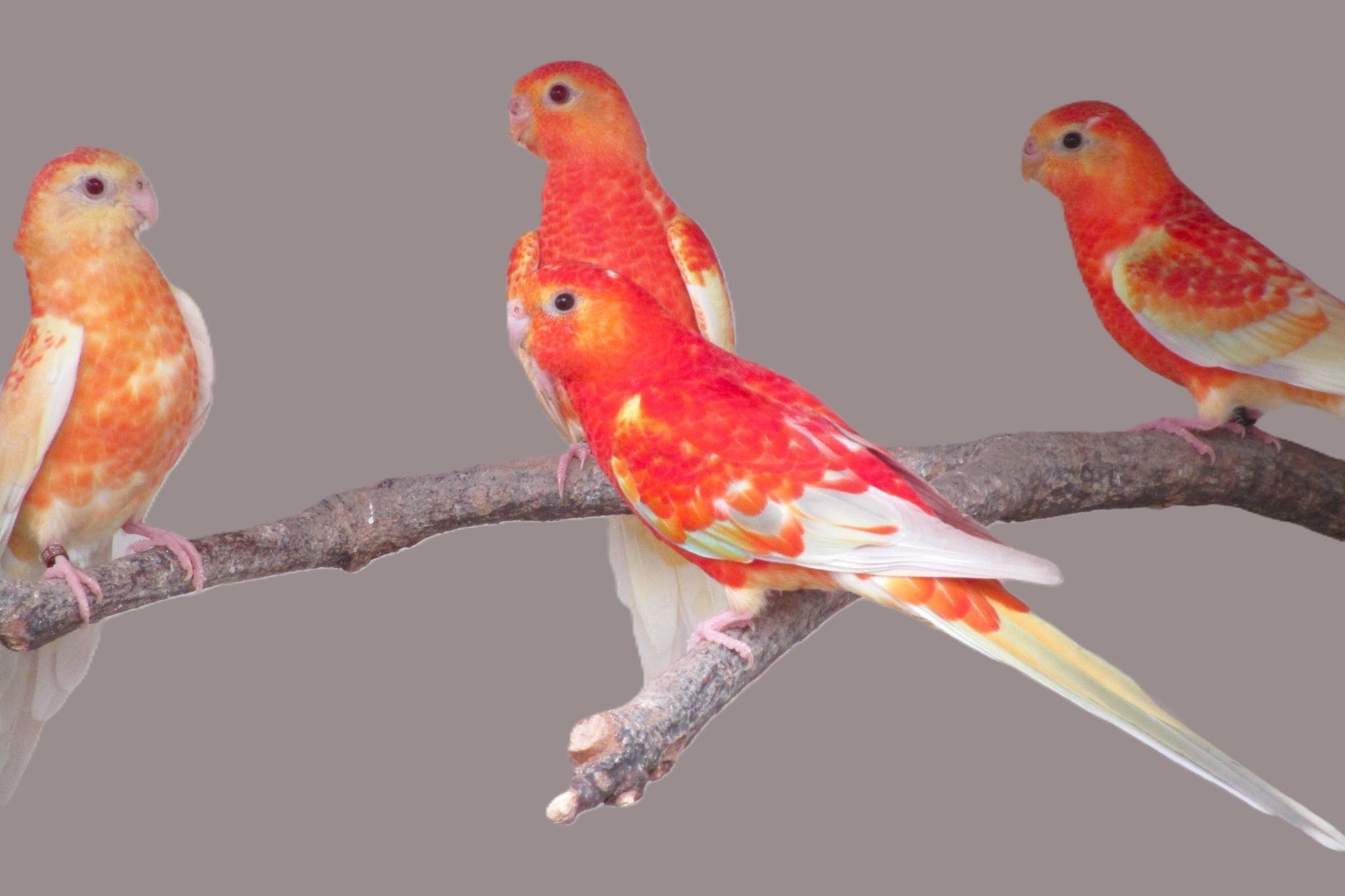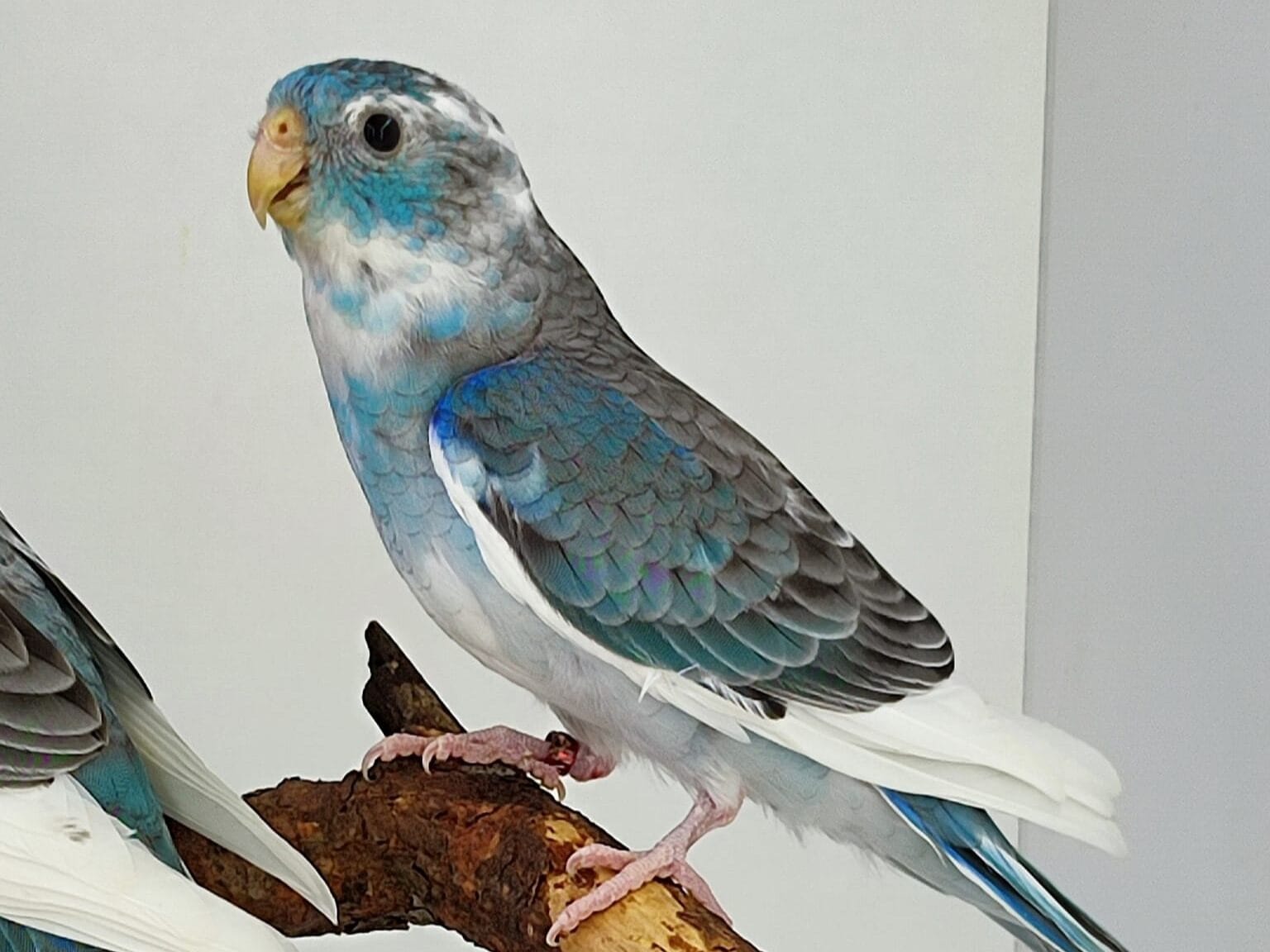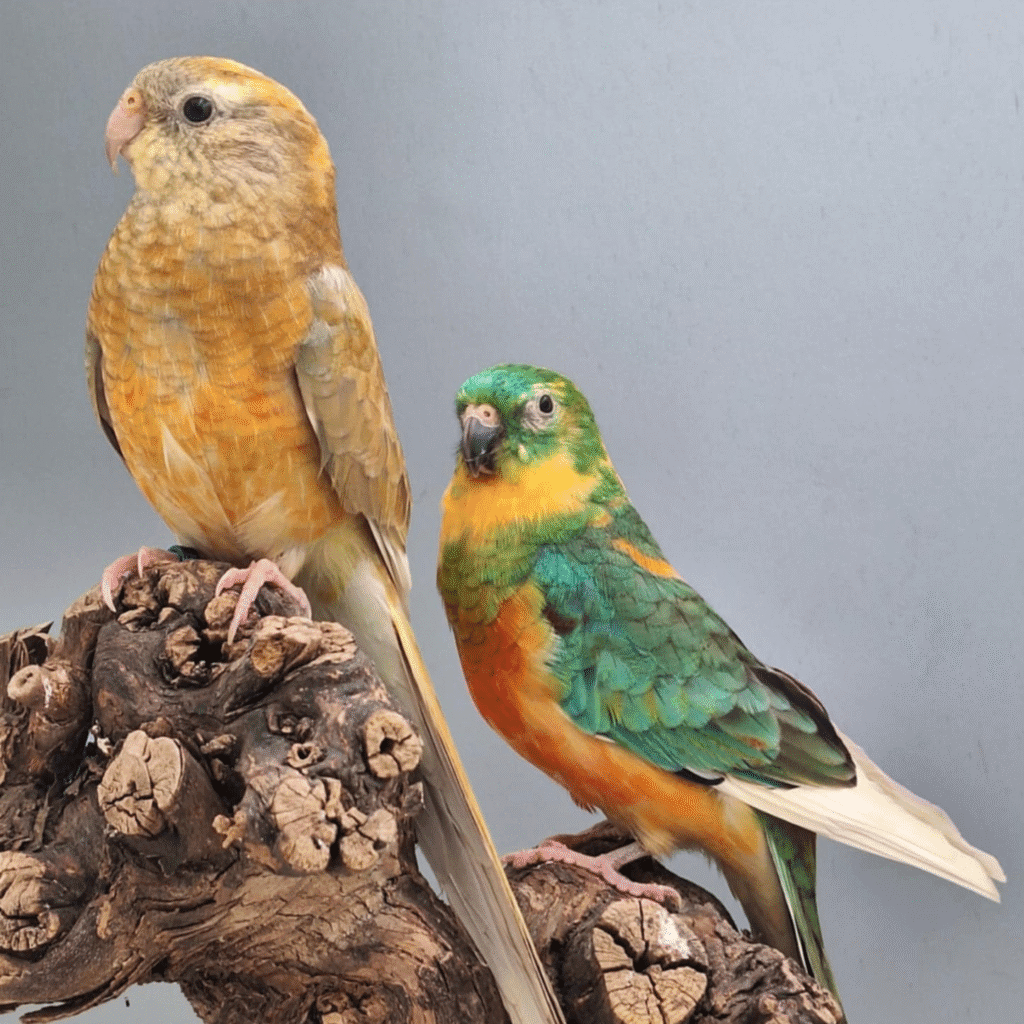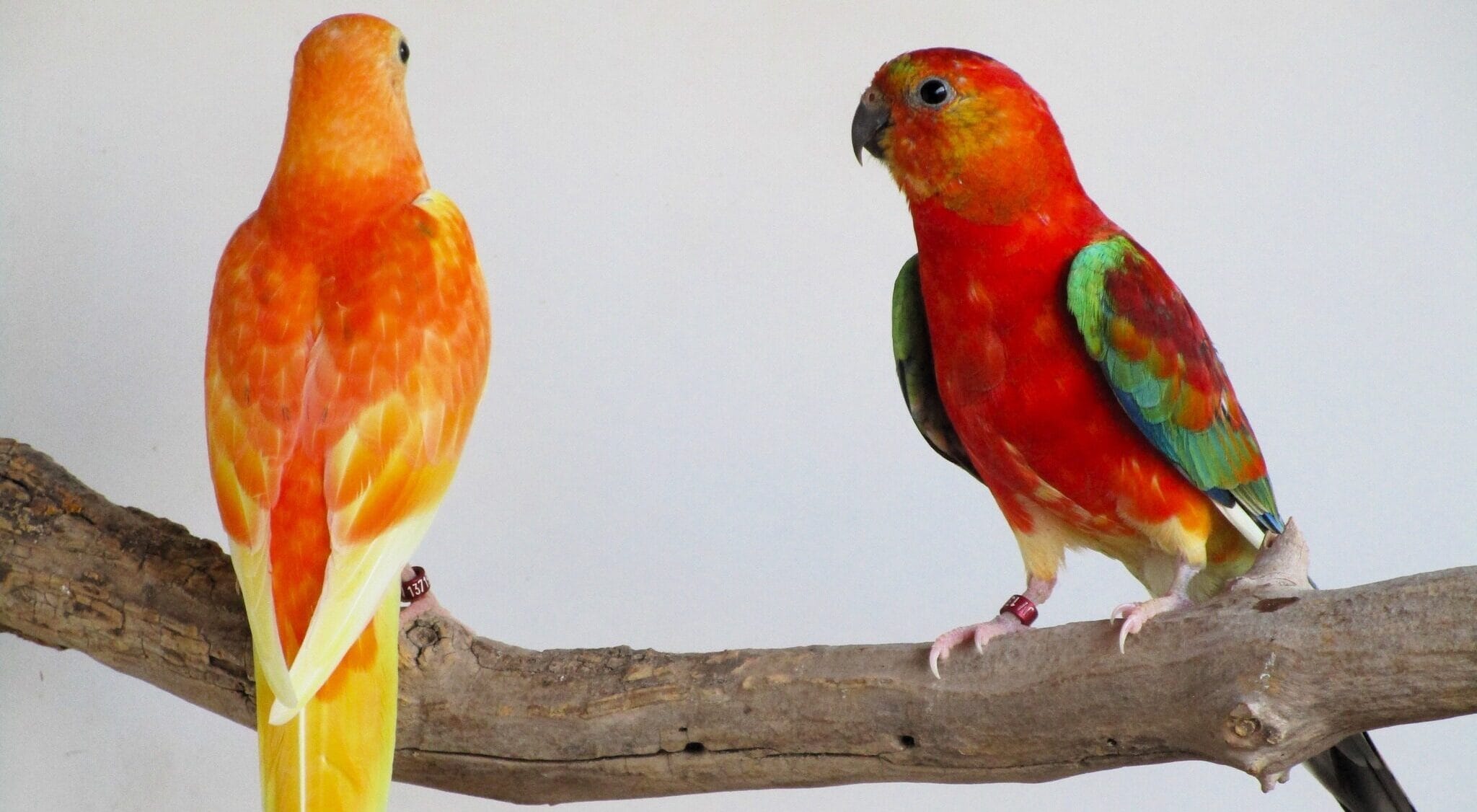How to Care for Red Rumped Parrots – 5 Essential Tips
Red Rumped Parrots stand as one of Australia’s most captivating avian species, distinguished by their vibrant plumage and distinctive behavioral patterns. These remarkable birds, scientifically known as Psephotus haematonotus, have captured the attention of ornithologists and bird enthusiasts worldwide due to their unique characteristics that set them apart from their parrot cousins.
Understanding the nuances between this parrot and other parrots becomes essential for potential owners, wildlife enthusiasts, and conservation efforts. This comprehensive analysis will illuminate the critical distinctions that make Red Rumped Parrots extraordinary within the diverse parrot family.
Table of Contents
Physical Characteristics
Size and Proportional Dimensions
This Parrot typically measures between 27-29 centimeters in length, positioning them within the medium-sized parrot category. Their proportional build exhibits a streamlined silhouette that distinguishes them from the more robust Eastern Rosellas or the compact Budgerigars. Their wingspan extends approximately 45-50 centimeters, creating an elegant flight profile.

Distinctive Plumage Patterns
The most striking feature of those Parrots lies in their chromatic distribution. Males showcase brilliant emerald-green dorsal coloration contrasted with golden-yellow ventral regions, while the eponymous red rump creates a spectacular visual accent. This tricolor scheme differs markedly from the more uniform coloration found in species like the Crimson Rosella.
Female displays more subdued olive-green tones with muted yellow underparts, reflecting evolutionary adaptations for nesting camouflage. This sexual dimorphism contrasts sharply with monomorphic species such as the Galah, where males and females appear virtually identical.
Cranial Features and Beak Morphology
Red Rumped Parrots possess relatively small, pale horn-colored beaks adapted for seed consumption and delicate manipulation. Their beak structure differs significantly from the powerful, curved mandibles of larger species like the Sulphur-crested Cockatoo, which require robust tools for cracking tough nuts and stripping bark.
Behavioral Distinctions of our colored Parrots
Social Dynamics and Flocking Behavior
Those Parrots exhibit fascinating social structures that differentiate them from gregarious species like Rainbow Lorikeets. While they form small family groups during breeding season, Red Rumped Parrots demonstrate more reserved social interactions compared to the highly communal behavior observed in many Australian parrot species.
Outside breeding periods, Red Rumped Parrots gather in loose aggregations of 20-50 individuals, contrasting with the massive flocks formed by Budgerigars that can number in the thousands. This moderate sociability reflects their ecological niche and territorial requirements.
Territorial and Aggressive Tendencies
Red Rumped Parrots display territorial behavior during breeding season that surpasses the intensity shown by many comparable species. Males establish and defend nesting territories with remarkable persistence, engaging in aerial displays and vocalizations that differ substantially from the ritualized combat seen in Cockatoos.
Habitat Preferences and Distribution Patterns
Geographical Range Specificity
Red Rumped Parrots occupy a distinctly different ecological niche compared to widespread species like the Australian King Parrot. Their distribution concentrates primarily in southeastern Australia, encompassing open woodlands, grasslands, and agricultural areas where they forage for grass seeds and herbaceous plants.
This habitat specificity contrasts with the adaptability demonstrated by species such as the Rainbow Lorikeet, which thrives in diverse environments from coastal regions to urban parks. Red Rumped Parrots require specific vegetation communities that provide both foraging opportunities and suitable nesting sites.
Altitude and Climate Preferences
This bird typically inhabits elevations below 1,000 meters, preferring temperate climate zones with moderate rainfall. This altitude preference differs from high-elevation specialists like the Australian King Parrot, which commonly occupies mountainous regions exceeding 1,200 meters elevation.

The 5 Key Differences Between Red Rumped Parrots and Other Species
Difference 1: Unique Foraging Behavior and Dietary Specialization
Red Rumped Parrots demonstrate ground-foraging behavior that distinguishes them from arboreal feeders like the Crimson Rosella. While most parrot species primarily feed in trees and shrubs, Red Rumped Parrots spend considerable time on the ground, methodically searching for fallen seeds and sprouting vegetation.
Their feeding technique involves a distinctive “shuffle-scratch” motion where they use both feet to disturb soil and leaf litter, revealing hidden seeds. This behavior contrasts with the typical “climb-and-pluck” feeding style exhibited by species such as the Eastern Rosella, which rarely ventures to ground level for sustained foraging sessions.
The dietary composition of Red Rumped Parrots focuses heavily on grass seeds, particularly from native species like Stipa and Danthonia. This specialization differs from the more varied diet of generalist species like the Galah, which consumes seeds, roots, shoots, and occasionally insects with equal enthusiasm.
Difference 2: Distinctive Nesting Requirements and Breeding Behavior
Red Rumped Parrots exhibit highly specific nesting preferences that set them apart from cavity-nesting specialists like the Cockatiel. They require deep, narrow tree hollows, typically in dead or dying eucalyptus trees, with entrance holes measuring 8-12 centimeters in diameter.
The breeding behavior of Red Rumped Parrots involves elaborate courtship rituals where males perform distinctive flight displays, combining rapid wing-beats with gliding sequences while producing specific vocalizations. This aerial courtship differs markedly from the ground-based displays performed by species like the Galah, which relies on head-bobbing and crest movements.
Female Red Rumped Parrots typically lay 4-6 glossy white eggs, incubating them for approximately 19-21 days. This incubation period falls within the shorter range compared to larger species like the Sulphur-crested Cockatoo, which requires 25-30 days for egg development.
Parental care responsibilities in Red Rumped Parrots demonstrate clear division of labor, with females handling incubation duties while males provide security and food provisioning. This contrasts with the shared incubation duties observed in species like the Rainbow Lorikeet, where both parents participate equally in egg warming.
Difference 3: Vocal Communications and Sound Repertoire
Red Rumped Parrots possess a distinctive vocal repertoire that differs significantly from the raucous calls of larger parrot species. Their primary contact call consists of a soft, musical “tsink-tsink” sound that carries well across open grasslands without the harsh, penetrating quality characteristic of Cockatoo vocalizations.
The alarm calls of Red Rumped Parrots feature rapid, staccato notes that increase in frequency and intensity when danger approaches. This contrasts with the single, explosive alarm calls produced by species like the Australian King Parrot, which relies on volume rather than complexity for threat communication.
During breeding season, male Red Rumped Parrots produce soft, warbling songs that incorporate mimicked elements from other bird species. This vocal versatility differs from the more limited repertoire of species like the Budgerigar, which primarily relies on repetitive chirping patterns for communication.
Difference 4: Flight Patterns and Aerial Capabilities
Red Rumped Parrots demonstrate distinctive flight characteristics that separate them from other Australian parrot species. Their flight pattern combines periods of rapid wing-beats with extended gliding phases, creating an undulating trajectory that differs from the direct, powered flight exhibited by species like the Galah.
The wing-loading ratio of Red Rumped Parrots enables efficient long-distance travel across open landscapes, contrasting with the shorter, more maneuverable flight patterns of forest-dwelling species like the Crimson Rosella. This adaptation reflects their ecological requirements for covering extensive territories while foraging for scattered food resources.
Red Rumped Parrots exhibit remarkable aerial agility during courtship displays and territorial encounters, performing tight spirals and rapid directional changes that exceed the capabilities of heavier species like the Sulphur-crested Cockatoo. These aerobatic abilities serve both reproductive and defensive functions in their behavioral repertoire.

Difference 5: Seasonal Movement Patterns and Migration Behavior
Red Rumped Parrots exhibit partial migratory behavior that distinguishes them from sedentary species like the Eastern Rosella. Populations in cooler, inland regions undertake seasonal movements toward warmer, coastal areas during winter months, while birds in temperate zones may remain resident year-round.
These seasonal movements follow predictable routes and timing, with Red Rumped Parrots gathering in specific staging areas before undertaking coordinated flights. This behavior contrasts with the nomadic movements of species like the Budgerigar, which respond opportunistically to rainfall and food availability without established migration corridors.
The timing of seasonal movements in Red Rumped Parrots correlates with specific environmental cues, including temperature fluctuations and photoperiod changes. This precise timing mechanism differs from the more flexible movement patterns exhibited by species like the Galah, which may remain in favorable areas regardless of seasonal changes.
Comparative Analysis with Similar Species
Compared to Eastern Rosellas
Eastern Rosellas share some superficial similarities with Red Rumped Parrots, including size range and Australian distribution. However, Eastern Rosellas exhibit more pronounced sexual dimorphism, with males displaying brilliant red heads and breasts that create a dramatically different color scheme from the yellow-dominant plumage of Red Rumped Parrots.
The habitat preferences of these species diverge significantly, with Eastern Rosellas favoring wooded environments and forest edges, while Red Rumped Parrots prefer open grasslands and scattered woodland. This ecological separation reduces interspecific competition and allows both species to coexist in adjacent territories.
Compared to Crimson Rosellas
Crimson Rosellas represent a larger, more robust parrot species with predominantly red plumage that contrasts sharply with Red Rumped Parrots’ green-and-yellow coloration. The size difference becomes apparent when comparing body mass, with Crimson Rosellas weighing 120-140 grams compared to the 55-85 gram range typical of Red Rumped Parrots.
Behavioral differences between these species include feeding strategies, with Crimson Rosellas demonstrating stronger preferences for fruits and flowers, while Red Rumped Parrots maintain their specialization on grass seeds and ground vegetation.
Compared to Australian King Parrots
Australian King Parrots occupy a different ecological niche from Red Rumped Parrots, preferring dense forest environments and higher elevations. The striking sexual dimorphism in King Parrots, where males display brilliant red and green plumage while females remain predominantly green, contrasts with the more subtle differences between male and female Red Rumped Parrots.
Size comparisons reveal King Parrots as significantly larger birds, measuring 40-43 centimeters in length compared to the 27-29 centimeter range of Red Rumped Parrots. This size difference reflects different ecological roles and resource utilization strategies.
Conservation Status and Population Dynamics
Current Population Trends
Red Rumped Parrots maintain stable populations across most of their range, though localized declines have occurred in heavily modified agricultural landscapes. Their adaptability to pastoral environments has provided some resilience against habitat loss, contrasting with the more severe population pressures faced by forest-dependent species.
Population monitoring indicates that Red Rumped Parrots respond positively to conservation measures that preserve native grasslands and scattered tree cover. This habitat management approach differs from the old-growth forest protection required by species like the Glossy Black-Cockatoo.
Threats and Conservation Challenges
Primary threats to Red Rumped Parrots include habitat modification through intensive agriculture and the removal of hollow-bearing trees essential for nesting. These challenges differ from the threats facing species like the Orange-bellied Parrot, which faces extinction due to extremely small population sizes and narrow habitat requirements.
Climate change impacts on Red Rumped Parrots remain relatively moderate compared to specialist species, though shifts in rainfall patterns may affect grass seed production and timing of breeding cycles. Their broad diet and habitat flexibility provide some buffer against environmental changes.
Captive Care Considerations
Housing Requirements for Red Rumped Parrots
Red Rumped Parrots require spacious flight accommodations that reflect their natural movement patterns and exercise needs. Minimum cage dimensions should exceed 4 meters in length to accommodate their active flight behavior, contrasting with the more modest space requirements of less active species like Cockatiels.
The social needs of captive Red Rumped Parrots differ from highly gregarious species, as they can be maintained successfully in pairs or small groups without the complex social dynamics required by species like the Galah. This makes them more suitable for dedicated aviculturists rather than casual pet owners.
Dietary Requirements in Captivity
Captive Red Rumped Parrots thrive on diets that replicate their natural seed preferences, requiring high-quality grass seed mixtures supplemented with sprouted grains and fresh vegetation. This dietary approach differs from the fruit-heavy requirements of species like the Rainbow Lorikeet, which demands specialized nectar formulations.
Feeding schedules for Red Rumped Parrots should accommodate their natural ground-foraging behavior by providing scattered feeding opportunities that encourage natural foraging movements. This environmental enrichment contrasts with the simple bowl-feeding adequate for less behaviorally complex species.

Research and Scientific Studies
Recent Behavioral Research
Contemporary studies on Red Rumped Parrots have revealed sophisticated cognitive abilities including tool use and problem-solving skills that rival those observed in larger parrot species. This research challenges previous assumptions about intelligence correlations with brain size across parrot species.
Comparative studies examining vocalizations have identified unique acoustic properties in Red Rumped Parrots that enable efficient communication across open landscapes. These adaptations differ from the close-range communication systems developed by forest-dwelling species.
Genetic Studies and Taxonomy
Recent genetic analysis has confirmed the taxonomic distinctiveness of Red Rumped Parrots within the Psephotus genus, resolving previous uncertainties about their evolutionary relationships with other Australian parrot species. These findings support current conservation strategies focused on maintaining distinct population segments.
Phylogenetic studies indicate that Red Rumped Parrots diverged from their closest relatives approximately 3-4 million years ago, developing their specialized ecological adaptations through isolation in specific Australian habitats. This evolutionary history explains their unique combination of characteristics.
Future Outlook and Research Priorities
Conservation Priorities
Future conservation efforts for Red Rumped Parrots should focus on maintaining connectivity between fragmented populations and preserving critical breeding habitat. These priorities differ from the immediate intervention required by critically endangered species but remain essential for long-term population stability.
Research priorities include understanding the impacts of climate change on breeding success and developing habitat management protocols that benefit Red Rumped Parrots while supporting agricultural productivity. This integrated approach represents a model for conserving common species before they require emergency intervention.
Avicultural Developments
Advances in captive breeding techniques for Red Rumped Parrots continue to improve reproductive success rates and genetic diversity maintenance. These developments support both conservation goals and sustainable aviculture practices for this increasingly popular species.
Conclusion
Red Rumped Parrots represent a fascinating example of evolutionary specialization within the diverse Australian parrot fauna. Their unique combination of ground-foraging behavior, specific habitat requirements, distinctive vocalizations, specialized flight patterns, and seasonal movement behaviors clearly distinguishes them from other parrot species sharing their continental range.
Understanding these differences enhances our appreciation for the complexity of avian evolution and the importance of preserving the ecological conditions that support such specialized adaptations. Red Rumped Parrots serve as excellent ambassadors for Australian wildlife conservation, demonstrating how thorough species knowledge contributes to effective protection strategies.
The five key differences outlined in this analysis—foraging behavior, nesting requirements, vocal communications, flight patterns, and seasonal movements—provide a comprehensive framework for distinguishing Red Rumped Parrots from their relatives. This knowledge benefits wildlife enthusiasts, potential aviculturists, and conservation professionals working to ensure the continued prosperity of these remarkable birds.
As research continues to reveal new aspects of Red Rumped Parrots’ biology and behavior, our understanding of their unique position within the parrot family will undoubtedly expand, further highlighting the importance of protecting Australia’s extraordinary avian diversity for future generations to study and enjoy.
FAQ
How can I distinguish male and female Red Rumped Parrots in the wild?
Male Red Rumped Parrots display bright emerald-green backs with golden-yellow underparts and the distinctive red rump patch, while females show more subdued olive-green coloration with muted yellow tones throughout their plumage.
Do Red Rumped Parrots make good pets compared to other parrot species?
Red Rumped Parrots require experienced bird keepers due to their active nature and specific housing needs, making them more suitable for dedicated aviculturists rather than first-time parrot owners who might prefer calmer species like Cockatiels.
What time of year do Red Rumped Parrots typically breed?
Red Rumped Parrots generally breed from August to January in their native range, timing their reproductive cycle to coincide with abundant grass seed availability during spring and summer months.
Are Red Rumped Parrots endangered or threatened?
Red Rumped Parrots currently maintain stable populations and are not considered threatened, though they face localized pressures from habitat modification and require ongoing conservation attention to prevent future population declines.
Did you enjoy this article?
Help other pet lovers benefit too — Share it on social media! 🐾💚


Leave a Reply